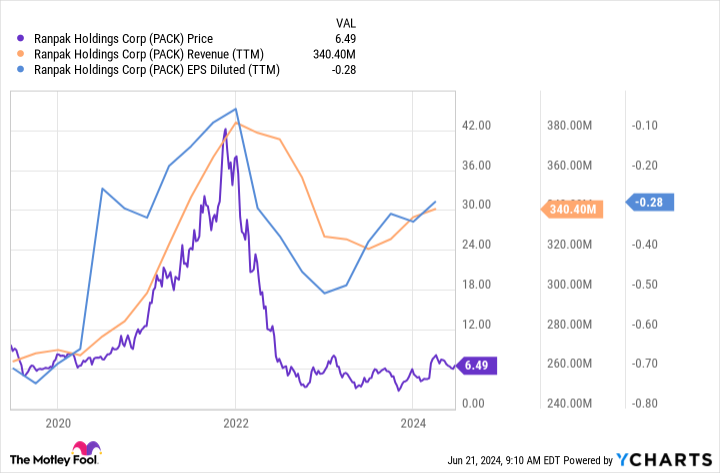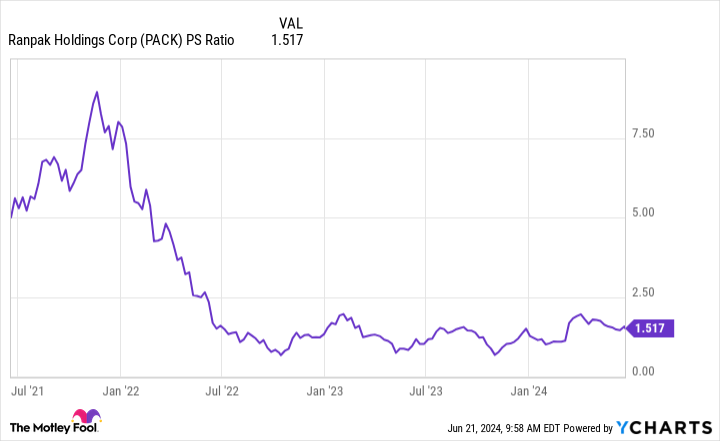The largest e-commerce company in the world, Amazon (NASDAQ: AMZN), the summer started with the announcement that we are ditching plastic. By the end of this year, the company hopes to replace 95% of the plastic cushions in its packaging with paper fillers. The company’s press release states this step “[w]I avoid almost 15 billion plastic inflatables every year.”
Many people probably processed this announcement by simply thinking about the environmental impact. But as an investor, my thoughts immediately went to something else: that’s a lot of plastic cushions that need to be replaced with paper. And I wondered if there was a company that could benefit from this decision by Amazon.
In fact it is. Ranpak Holdings (NYSE: PACKAGE) is a company that few investors have ever heard of. But it could become a sudden beneficiary of Amazon’s abrupt move.
Ranpak is a surprisingly strong company
Ranpak sells machines for filling, packaging and buffering packages. It also sells consumables for these machines. As of the first quarter of 2024, the company had installed 141,000 machines at various companies. And while these companies use their machines, they ultimately go back to Ranpak when they need more paper.
According to certain investor presentations, Amazon is already a Ranpak customer, although it’s unclear how big that customer is. Craig-Hallum analyst Greg Palm says Amazon belongs to Ranpak largest direct customer, according to The Fly. But this is not explicitly stated in Ranpak’s annual documents.
That said, 30% of Ranpak’s revenue in 2023 came from e-commerce businesses. This is important to keep in mind. The company also says that 11% of its revenue comes from direct customer purchases, while the rest comes from the business model of its distributors. So this is an indication of how big Amazon could be for Ranpak.
Ranpak won’t necessarily blow you away with growth or profit margins. But there is a certain power in the model. Once companies buy the machines, they have an incentive to continue using them. And as they consume the paper products, they need to replenish Ranpak’s inventory. This is a form of recurring revenue, and that’s a good thing. The company doesn’t reveal these financial figures, but does say its consumables have “high margins.”
What could happen after Amazon’s big move?
Ranpak went public with a special purpose acquisition company (SPAC) – the deal was completed in 2019. That’s why it has been trading under its current ticker symbol for almost five years. As the chart below shows, revenue growth and earnings per share (EPS) outperformed the stock’s performance.

Ranpak’s sales and profits could be about to get a bigger boost as Amazon moves to replace 15 billion plastic pillows with paper. Ranpak won’t necessarily be Amazon’s sole supplier, but the boost to its business could be meaningful. Furthermore, the increase in profitability could be even more pronounced as management says consumable paper delivers higher margins.
Additionally, Craig-Hallum’s Palm theorizes that Amazon’s decision could create a wave of unrest in the e-commerce world. Following the industry leader’s lead, more companies could similarly move away from plastic in the coming months. With 30% of its sales coming from e-commerce companies, this secondary ripple effect could be an increasingly big deal for Ranpak.
I’ve avoided giving concrete numbers when it comes to the potential upside for Ranpak because investors simply don’t have enough information to be that precise. There are many unanswered questions.
However, here are some encouraging things for investors to consider with Ranpak today. First, the stock is reasonably priced. At the time of writing, it has a price-to-sales ratio (P/S) of around 1.5 – that’s typical for a low-growth company.


Investors don’t have to pay for Ranpak shares; the valuation is reasonable.
The other important thing to keep in mind is that Ranpak is a low-risk investment in my opinion. Because the operations include an element of recurring revenue, the financial results are consistent. It’s unreasonable to worry that something will suddenly change, putting the business at risk.
In other words, if Amazon’s move to paper doesn’t bring any benefits, Ranpak’s business should continue as it is now. The stock won’t necessarily rise. But I didn’t expect it to go south.
However, if Amazon’s move to paper pays dividends, the upside for Ranpak could be significant. Moreover, if other e-commerce companies follow Amazon’s lead, Ranpak’s financial results could soar.
I don’t believe the market is pricing in this potential upside from Ranpak stock today, which is why this is an interesting opportunity. It won’t make many headlines. But this could be an under-the-radar way to capitalize on Amazon’s packaging announcement.
Should you invest $1,000 in Ranpak now?
Before buying shares in Ranpak, consider the following:
The Motley Fool stock advisor The analyst team has just identified what they think is the 10 best stocks for investors to buy now… and Ranpak wasn’t one of them. The ten stocks that survived the cut could deliver monster returns in the coming years.
Think about when Nvidia created this list on April 15, 2005… if you had $1,000 invested at the time of our recommendation, you would have $775,568!*
Stock Advisor provides investors with an easy-to-follow blueprint for success, including portfolio building guidance, regular analyst updates, and two new stock picks per month. The Stock Advisor is on duty more than quadrupled the return of the S&P 500 since 2002*.
View the 10 stocks »
*Stock Advisor returns June 10, 2024
John Mackey, former CEO of Whole Foods Market, an Amazon subsidiary, is a member of The Motley Fool’s board of directors. Jon Quast has no position in any of the stocks mentioned. The Motley Fool has positions in and recommends Amazon. The Motley Fool has a disclosure policy.
Amazon is ditching plastic and switching to paper fillers. Here are the hidden small-cap stocks that could rise as a result. was originally published by The Motley Fool







